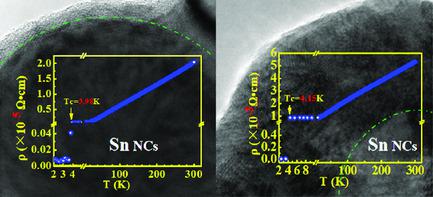当前位置:
X-MOL 学术
›
physica status solidi (b)
›
论文详情
Our official English website, www.x-mol.net, welcomes your feedback! (Note: you will need to create a separate account there.)
Effects of Outer Shell Layer on the Electronic Transport Behaviors of Sn@SnOx Nanoparticles
physica status solidi (b) Pub Date : 2020-11-30 , DOI: 10.1002/pssb.202000430 Ang Ding 1 , Tianjun Li 1 , Dongxing Wang 1 , Javid Muhammad 2 , Asif Shah 2 , Xinglong Dong 2 , Zhidong Zhang 3
x x x x x x x x x T c . Superconductivity occurs in both Sn@SnOx T c . The T c of the two NCs (3.98 K, 4.15 K) is slightly higher than that of the metal block (3.73 K) due to the electron‐scattering effect of the particles' surface shell. The resistances of the two samples below T c show an exponential decay mode, which is the result of the thermally activated phase slip (TAPS) and quantum phase slip (QPS).
中文翻译:

外壳层对Sn@SnOx纳米颗粒电子输运行为的影响
氧化锡封装的锡纳米颗粒(Sn@SnOX X X X X X X X X 时间 C 。Sn@SnO 中都存在超导性X 时间 C 。这时间 C 由于颗粒表面壳的电子散射效应,两个NC的(3.98 K,4.15 K)略高于金属块(3.73 K)。下面两个样品的电阻时间 C 显示指数衰减模式,这是热激活相滑移(TAPS)和量子相滑移(QPS)的结果。
physica status solidi (b) Pub Date : 2020-11-30 , DOI: 10.1002/pssb.202000430 Ang Ding 1 , Tianjun Li 1 , Dongxing Wang 1 , Javid Muhammad 2 , Asif Shah 2 , Xinglong Dong 2 , Zhidong Zhang 3
Affiliation

|
中文翻译:

外壳层对Sn@SnOx纳米颗粒电子输运行为的影响



























 京公网安备 11010802027423号
京公网安备 11010802027423号